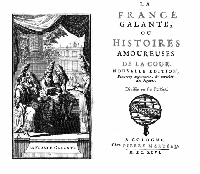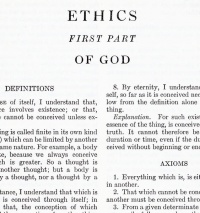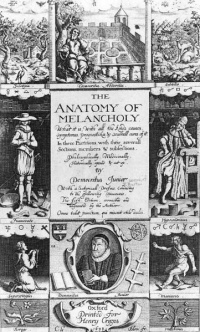17th century in literature
From The Art and Popular Culture Encyclopedia
| Revision as of 08:44, 17 October 2019 Jahsonic (Talk | contribs) ← Previous diff |
Revision as of 08:45, 17 October 2019 Jahsonic (Talk | contribs) Next diff → |
||
| Line 12: | Line 12: | ||
| ==Notable works== | ==Notable works== | ||
| *[[Miguel de Cervantes]], ''[[Don Quixote]] de la Mancha'' ([[1605]]). | *[[Miguel de Cervantes]], ''[[Don Quixote]] de la Mancha'' ([[1605]]). | ||
| - | *[[Honoré d'Urfé]], ''[[L'Astrée]]'' (1607-27) | + | *''[[L'Astrée]]'' (1607-27) by Honoré d'Urfé |
| - | + | ||
| - | *''[[Conversations on the Plurality of Worlds]]'' | + | |
| - | + | ||
| - | + | ||
| *[[Miguel de Cervantes]], ''[[Novelas Exemplares]]'' ([[1613]]). | *[[Miguel de Cervantes]], ''[[Novelas Exemplares]]'' ([[1613]]). | ||
| *[[Robert Burton (scholar)|Robert Burton]], ''[[The Anatomy of Melancholy]]'' ([[1621]]). | *[[Robert Burton (scholar)|Robert Burton]], ''[[The Anatomy of Melancholy]]'' ([[1621]]). | ||
| Line 30: | Line 26: | ||
| *[[Aphra Behn]], [[Love-Letters between a Nobleman and his Sister]] ([[United Kingdom|British]], [[1684]]/[[1685]]/[[1687]]), the first full blown epistolary novel. | *[[Aphra Behn]], [[Love-Letters between a Nobleman and his Sister]] ([[United Kingdom|British]], [[1684]]/[[1685]]/[[1687]]), the first full blown epistolary novel. | ||
| *[[John Wilmot]], ''[[Sodom, or the Quintessence of Debauchery]]'' (1684) | *[[John Wilmot]], ''[[Sodom, or the Quintessence of Debauchery]]'' (1684) | ||
| + | *''[[Conversations on the Plurality of Worlds]]'' (1686) by Bernard le Bovier de Fontenelle | ||
| *[[Aphra Behn]], ''[[Oroonoko]]'', ([[United Kingdom|British]], [[1688]]). | *[[Aphra Behn]], ''[[Oroonoko]]'', ([[United Kingdom|British]], [[1688]]). | ||
| *[[François Fénelon]], ''[[The Adventures of Telemachus]]'', ([[French]], [[1699]]). | *[[François Fénelon]], ''[[The Adventures of Telemachus]]'', ([[French]], [[1699]]). | ||
Revision as of 08:45, 17 October 2019


|
Related e |
|
Featured: |
The invention of movable type printing subjected both novels and romances to a first wave of trivialisation and commercialisation. Printed books were expensive, yet something people would buy, just as people still buy expensive things they can barely afford. Alphabetisation, or the rise of literacy, was a slow process when it came to writing skills, but was faster as far as reading skills were concerned. The Protestant Reformation afforded readers of religious pamphlets, newspapers and broadsheets.
Bestselling genres of the time are the pastoral and heroic romances, the picaresque novel, comic fiction and the works of Cervantes. Although written in the previous century, Brantôme's Les Vies, published in the middle of the century set a trend for the emergence of a European market for scandal literature.
Contents |
Notable works
- Miguel de Cervantes, Don Quixote de la Mancha (1605).
- L'Astrée (1607-27) by Honoré d'Urfé
- Miguel de Cervantes, Novelas Exemplares (1613).
- Robert Burton, The Anatomy of Melancholy (1621).
- Procopius, Secret History (1623).
- Francisco de Quevedo, El buscón (Spanish, 1626), masterpiece of the picaresque subgenre.
- Paul Scarron, Roman Comique (1651)
- Madeleine de Scudéry, Clélie, histoire romaine (10 vols. between 1654 and 1660)
- Pierre de Bourdeille, seigneur de Brantôme, Les Vies des Dames Galantes (1665-1666)
- Hans Jakob Christoffel von Grimmelshausen, Simplicissimus (German, 1668/1669), the Thirty Years War put into satirical autobiography.
- Anonymous, Letters of a Portuguese Nun (1669)
- Madame de La Fayette, Zayde (1670)
- Madame de La Fayette, La Princesse de Clèves (1678)
- Aphra Behn, Love-Letters between a Nobleman and his Sister (British, 1684/1685/1687), the first full blown epistolary novel.
- John Wilmot, Sodom, or the Quintessence of Debauchery (1684)
- Conversations on the Plurality of Worlds (1686) by Bernard le Bovier de Fontenelle
- Aphra Behn, Oroonoko, (British, 1688).
- François Fénelon, The Adventures of Telemachus, (French, 1699).
Bestsellers
The works that gained the greatest fame—Honoré d'Urfé's L'Astrée (1607-27), John Barclay's Argenis (1625-26), Madeleine de Scudéry′s ‚Clelie or Anton Ulrich von Braunschweig's Römischer Octavia (Octavia the Roman, 1679-1714)—were esteemed both as explorations of the ancient world and as works one would read with an interest in modern life. These heroic romances encapsulated present histories clad in ancient costumes and dove into the realm of the roman à clef, the novel readers would decipher with a key that betrayed who was who within this fictional world. The present fashions of courtly conduct could in the event be found nowhere in such perfection as in these seemingly historical romances. Readers used them as models for their own elegant compliments, letters, and speeches.
Theory
Notable writers
Spain
- Pedro Calderón de la Barca, Spanish dramatist (1600 – 1681)
- Miguel de Cervantes Saavedra, Spanish author (1574 – 1616)
- Francisco de Quevedo, Spanish writer (1580 – 1645)
- Félix Lope de Vega, Spanish playwright and poet (1562 – 1635)
France
- Pierre Corneille, French dramatist (1606 – 1684)
- Nicolas Boileau-Despréaux, French poet and critic (1636 – 1711)
- Jean de La Fontaine, French poet (1621 – 1695)
- Molière, French dramatist, actor, director (1622 – 1673)
- Jean Racine, French dramatist (1639 – 1699)
England
- William Shakespeare, English author and poet (1564 – 1616)
- Daniel Defoe, English writer, novelist (1659 or 1661 – 1731)
- John Wilmot, 2nd Earl of Rochester, English poet (1647 – 1680)
- John Donne, English metaphysical poet (1572 – 1631)
- John Dryden, English poet, literary critic, translator, and playwright (1631 – 1700)
- Ben Jonson, English dramatist c.1572 – 1637)
- John Milton, English author and poet (1608 – 1674)
- Samuel Pepys, English civil servant and diarist (1633 – 1703)
Germany
- Andreas Gryphius, German poet and dramatist (1616 – 1664)
Events and trends
- 1660-1669 - Samuel Pepys writes his diary.
- 1667-1668 - Marianna Alcoforado writes her Letters of a Portuguese Nun.
- Metaphysical poets
- German literature of the Baroque period
- Emblem books
- Heroic romances
- Novel of manners
- Gallant literature
- Pierre Marteau and anomymous publishing
See also
- list of literary births and deaths in the 17th century
- list of new books and plays published in the 17th century



